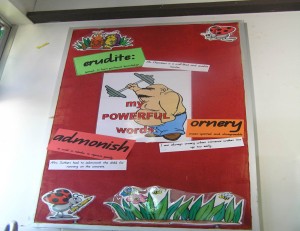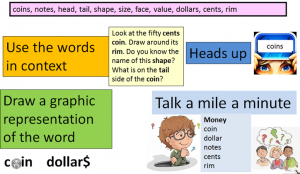Understanding the Reading Process – The Big Six

My powerful words poster for a week
In my role, I deliver a lot of professional development and I love presenting a session on vocabulary. I was lucky enough to ‘inherit’ an original professional development session on vocabulary from my mentor and friend, Kay and her colleague, Chris. Over the years, I have delivered several vocabulary sessions and I don’t think any one session has been the same.
I am always reading new research and incorporating new ideas and strategies and there are a couple of ideas in Konza’s papers that I will use in a session I am running in a few weeks. In today’s blog, I will be summarising Konza’s synthesis of research on vocabulary, both from her original paper and the supporting vocabulary paper.
Vocabulary
Bromley (2007, p 528) wrote vocabulary is a principal contributor to comprehension, fluency and achievement. Vocabulary development is both an outcome of comprehension and a precursor to it, with word meanings making up as much s 70-80% of comprehension.
Vocabulary is a key component of reading and if students know the meaning of a word, there is far more chance that they will be able to read the word and make meaning of the sentence. Vocabulary is generally learnt indirectly through repeated exposure – conversations, listening to stories, reading and through the media.
Some children will arrive at school as highly competent vocabulary users and will absorb words easily. They will be more likely to acquire the skills of reading easily and thereby continue to build their vocabulary knowledge. Other children come to school with small vocabularies and are often not skilled in learning new words, have a more restricted range of words and less access to the vocabulary of books. Consequently, they are more likely to have difficulty acquiring the skills of reading and will be unable to use the skills of reading to develop vocabulary further.
A number of researchers have found that direct instruction is effective for vocabulary growth in all students. In primary school, a rich bank of words that permeate across many contexts needs to be developed. ‘Rich and robust’ (Beck & McKeown, 2002) vocabulary development entails careful choice of words for instruction, strategies that develop deep understanding, regular use and an increasing ‘word consciousness’ in all students. Biemiller (2010) recommends teaching as many new words as possible and Pressley et al (2007) advocates ‘flooding’ classrooms with a range of long-term vocabulary interventions. Konza’s paper on vocabulary includes guidelines and strategies from all three ‘schools of thought’.
Guidelines and Strategies for Vocabulary Development
1. Build vocabulary instruction into everyday routine
- model high quality language.
- incorporate vocabulary building into directions and teaching.
- organise frequent small group interactions to build oral language.
- preteach critical vocabulary.
2. Select the best words to teach
- Konza lists 5 questions that will help with word selection (see her paper).

Some tier 2 and tier 3 words for a year 2 maths unit
- There are three tiers of words: Tier 1 – basic and high frequency words; Tier 2 – words that appear more frequently in text than in oral language and are less likely to be learnt without assistance; and Tier 3 – subject specific words.
- Tier 2 words should be the focus of direct vocabulary instruction – maximum of 7-10 Tier 2 words from any one book or piece of text.
3. Explicitly teach word meanings
- Read aloud the sentence and show the word.
- Have students repeat it several times – brainstorm meanings – look for helpful parts – reread the sentence.
- Explain the meaning with a student-friendly definition and synonyms.
- Provide examples.
- Ask questions to determine understanding.
- Provide sentences that students can judge as being true or false.
- Students write own sentences to be judged true or false.
- Consciously use the word throughout the following days.
4. Teach students to use contextual strategies
- An example are words that may be in bold or italics – indicates important or new terms and are often explained in a glossary.
5. Teach students to use graphic organisers to explain word meanings
- using concept maps, word trees, word maps and Y charts are different ways of explaining word meanings in detail.
- help students develop a clear and accurate concept of a word.

Using the online instagrok to form a word map
Goal
The goal is to develop ‘word consciousness’ – enjoying learning new words and using them in different ways. Teachers who appreciate and enjoy words and understand the power and value of a rich vocabulary pass that enthusiasm and knowledge on to their students.

Enjoying the English language
